Contributing to Sustainability Education of East Asian University Students through a Field Trip Experience: A Social-Ecological Perspective
Abstract
:1. Introduction
2. Materials and Methods
2.1. Description of the Field Trip Environmental Education Program
2.2. Field Sites
- Jeju Island (Days 2 and 3): Jeju Island is the most famous tourism area in Korea with various volcanic landscapes, beautiful scenery and a distinct cultural heritage. The following four sites in Jeju Island illustrate the diverse patterns of interaction between the valuable environments, cultural heritage and development of tourism. Jeju Island has 368 Oreums, which means “parasitic volcanos” in the Jeju dialect. The participants hiked along a trail in Geomun Oreum, which was designated as a UNESCO World Heritage Site in 2007, and experienced the well-preserved environment. Visiting a managed forest (Hannam Experimental Forest) provided a case of sustainable forest management and an opportunity to walk, breathe and relax in a cedar forest (i.e., forest bathing [41]). The participants learned about the traditional culture of Jeju, which adapted to the inadequate island environment and resources, by visiting Jeju Folklore & Natural History Museum and Jeju Folk Village. The Olle Trail is a series of walking trails along Jeju’s coastline, where visitors see beautiful nature and have contact with the locals. It suggests an alternative way of sustainable tourism beyond the usual mass tourism. The participants took a short walk on the Olle Trail. All visits were guided by local experts.
- Saemangeum Sea Dike (Day 4): Saemangeum, which is an estuarine tidal flat on the coast of the Yellow Sea, represents a case of intensive environmental management through dike construction and landfill. The Saemangeum Sea Dike Project from 1993–2010 dammed Saemangeum with a 33.9 km-long dike and remade the estuarine tidal flat into 28.3 km2 of land. The project caused a large environmental conflict among the government, local people, NGOs, religious communities, politicians and scholars because of the potential impacts on habitats, biodiversity and water quality. Now, infrastructures on the reclaimed land are under construction depending on their agricultural, industrial, residential, research and recreational uses. The participants visited the dike and listened to lectures from the project office and a local NGO, who had opposing perspectives on the sea dike and its environmental impact. Finally, the participants conducted a tree-planting activity on the reclaimed land for both educational, as well as ceremonial purposes.
- Demilitarized Zone (DMZ) (Day 5): The DMZ, which is a strip of land running across the border between North and South Korea since the end of the Korean War, 1953, represents a novel environment with interaction between diplomacy and the environment. The DMZ is an approximately 4 km-wide buffer zone out of which the militaries in the two countries face each other. Because military and civilian activities are extremely controlled within and around the DMZ, environment and biodiversity in the DMZ area is significantly protected [42]. The participants visited migratory bird habitats and observatories to watch the landscape of the controlled DMZ area, as guided by a local NGO activist.
- Seoul (Day 6): Seoul, the capital city of South Korea, is a highly urbanized environment with a population of about 10 million. Since the 1960s, the landscape of Seoul has rapidly shifted to an urban system alongside the increase of population, infrastructure, land cover and urban sprawl. Two sites, Nanji Park and the Cheonggyecheon Stream, demonstrated the history of environmental problems resulting from modernization and successful cases of restoration from a degraded environment. Nanji area was a past landfill site where 90 million m3 of garbage were dumped from Seoul from 1978–1993. The landfill during the 15 years left two garbage hills 100 m high with contaminated soil, leachates and gases, in addition to degraded habitats. The restoration project aimed at land stabilization, leachate and gas treatment, and park creation was carried out after the landfill site closed in 1993. Finally, Nanji Park was opened to the public in 2002. The Cheonggyecheon Stream, which crosses downtown Seoul, was covered up with concrete for a road and elevated highway during the 1960s–1990s. The concrete infrastructures on the Cheonggyecheon Stream promoted the functions for industrialization and modernization in Seoul, such as traffic and sewage discharge. However, as time passed and the concrete aged, the stream needed to be renovated with the new sociocultural values instead of the former values of industrialization and modernization. It was placed under a restoration project from 2003–2005; the concrete was removed, and stream flow and green spaces were established. The restoration project improved the landscape of the Cheonggyecheon Stream and downtown Seoul. However, the project’s aims and processes were a source of significant conflicts between the Seoul Metropolitan Government and NGOs, who held different perspectives on the environment and politics [43]. For example, environmentalists argued that there was a lack of naturalness in the water flow, which was artificially pumped from the Han River. Nowadays, the two sites are visited by many people for numerous purposes, such as recreation, tourism and education, and they symbolize environmental restoration in Seoul. The participants visited the sites and management offices, attended lectures given by the managers and talked with citizens about the environmental problems in Korea. We encouraged them to incorporate ideas they learned from the talks with citizens at the Cheonggyecheon Stream into the group presentation.
2.3. Analysis of the Field Trip Experience
3. Results
3.1. Questionnaire Analysis on Participants’ Learning from an Evaluation of the Field Trip Program
3.2. Qualitative Analysis of Participants’ Statements on the Experience of the Field Trip Program
3.3. Site Evaluations for the Field Trip Program
4. Discussion
4.1. Constructive Learning and Education for Building a Social-Ecological System
4.2. Field Trip Design for Environmental Education
4.3. Environmental Education in the Context of Corporate Social Responsibility (CSR)
5. Conclusions
Supplementary Materials
Acknowledgments
Author Contributions
Conflicts of Interest
Appendix A
| Characteristics | Frequency | Characteristics | Frequency | |
|---|---|---|---|---|
| Gender | Academic major | |||
| Female | 48 (62%) | Arts | 4 (5%) | |
| Male | 30 (38%) | Business and economics | 18 (23%) | |
| Nationality | Education | 2 (3%) | ||
| China | 22 (28%) | Engineering and technology | 9 (12%) | |
| Japan | 16 (21%) | Environment-related study | 19 (24%) | |
| South Korea | 21 (27%) | Law | 4 (5%) | |
| Vietnam | 19 (24%) | Literature and language | 6 (8%) | |
| Age | Medical and natural science | 9 (11%) | ||
| Under 20 | 9 (12%) | Social science | 7 (9%) | |
| 20–22 | 49 (63%) | Experience of participation in environmental programs | ||
| 23–25 | 16 (21%) | Actively involved | 13 (17%) | |
| 26–28 | 3 (4%) | A few times | 40 (51%) | |
| 29 and over | 1 (1%) | No | 23 (29%) | |
| Academic year | No response | 2 (3%) | ||
| Freshman | 6 (8%) | Motivation for participating in the program | ||
| Sophomore | 19 (24%) | Interest in environmental topics | 46 (44%) | |
| Junior | 22 (28%) | International friendship and experience | 30 (29%) | |
| Senior | 17 (22%) | Tourism in many places of Korea | 17 (16%) | |
| Graduate school | 14 (18%) | Participation in and lessons about environmental practices | 12 (11%) | |
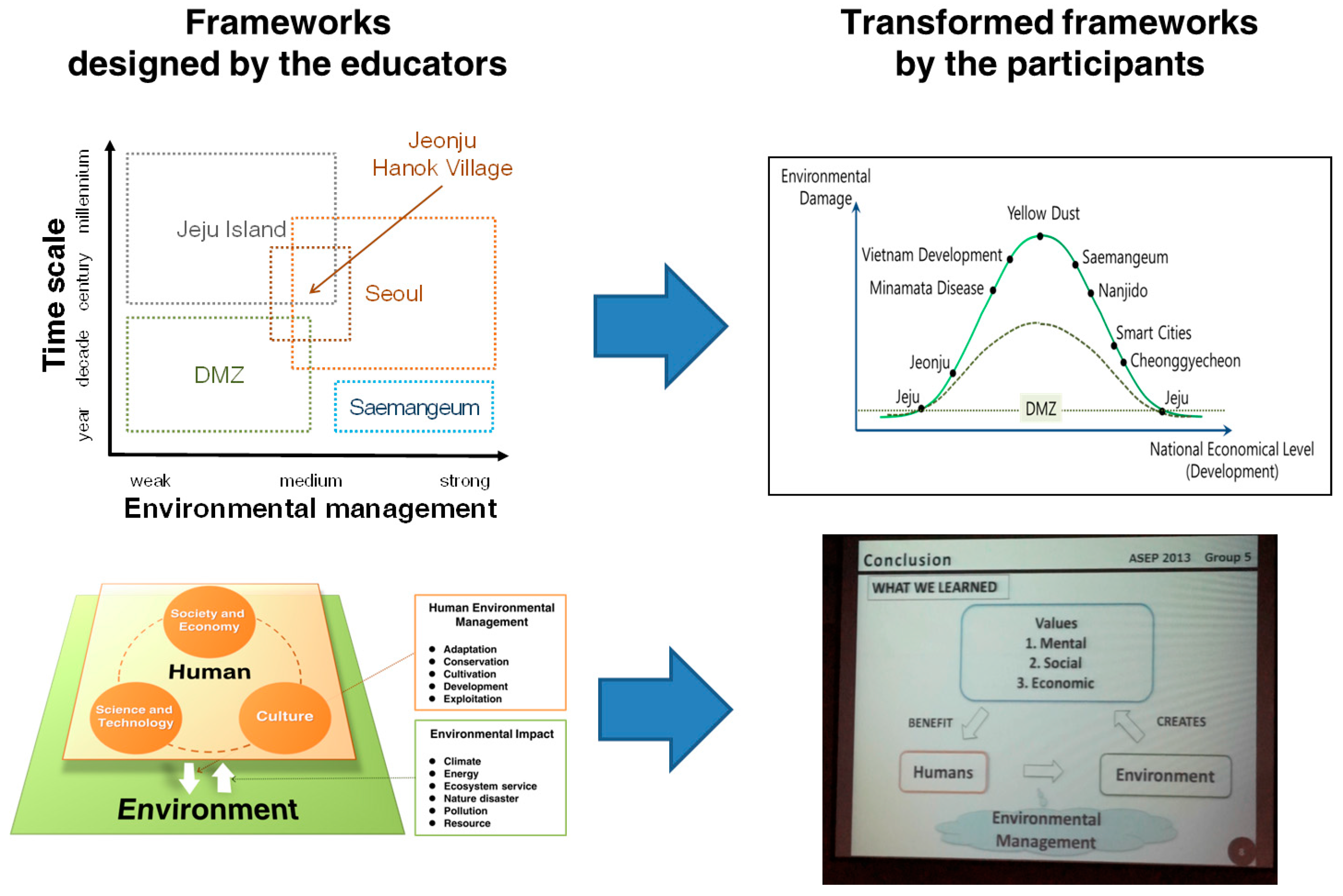
References
- Gunderson, L.H. Ecological resilience—In theory and application. Annu. Rev. Ecol. Syst. 2000, 31, 425–439. [Google Scholar] [CrossRef]
- Holling, C.S.; Gunderson, L.H. Resilience and adaptive cycles. In Panarchy: Understanding Transformations in Human and Natural Systems; Holling, C.S., Gunderson, L.H., Eds.; Island Press: Washington, DC, USA, 2002; pp. 25–62. [Google Scholar]
- Folke, C. Resilience: The emergence of a perspective for social–ecological systems analyses. Glob. Environ. Chang. 2006, 16, 253–267. [Google Scholar] [CrossRef]
- Plummer, R. Social–ecological resilience and environmental education: Synopsis, application, implications. Environ. Educ. Res. 2010, 16, 493–509. [Google Scholar] [CrossRef]
- Blackmore, C. What kinds of knowledge, knowing and learning are required for addressing resource dilemmas?: A theoretical overview. Environ. Sci. Policy 2007, 10, 512–525. [Google Scholar] [CrossRef]
- Krasny, M.E.; Roth, W.M. Environmental education for social-ecological system resilience: A perspective from activity theory. Environ. Educ. Res. 2010, 16, 545–558. [Google Scholar] [CrossRef]
- Schultz, L.; Lundholm, C. Learning for resilience? Exploring learning opportunities in biosphere reserves. Environ. Educ. Res. 2010, 16, 645–663. [Google Scholar] [CrossRef]
- Sriskandarajah, N.; Bawden, R.; Blackmore, C.; Tidball, K.G.; Wals, A.E.J. Resilience in learning systems: Case studies in university education. Environ. Educ. Res. 2010, 16, 559–573. [Google Scholar] [CrossRef]
- Sterling, S. Learning for resilience, or the resilient learner? Towards a necessary reconciliation in a paradigm of sustainable education. Environ. Educ. Res. 2010, 16, 511–528. [Google Scholar] [CrossRef]
- Lozano, R.; Lozano, F.J.; Mulder, K.; Huisingh, D.; Waas, T. Advancing higher education for sustainable development: International insights and critical reflections. J. Clean. Prod. 2013, 48, 3–9. [Google Scholar] [CrossRef]
- Spellman, K.V. Educating for resilience in the North: Building a toolbox for teachers. Ecol. Soc. 2015, 20. [Google Scholar] [CrossRef]
- Knapp, D.; Barrie, E. Content evaluation of an environmental science field trip. J. Sci. Educ. Technol. 2001, 10, 351–357. [Google Scholar] [CrossRef]
- DeWitt, J.; Storksdieck, M. A short review of school field trips: Key findings from the past and implications for the future. Visit. Stud. 2008, 11, 181–197. [Google Scholar] [CrossRef]
- Bonney, R.; Cooper, C.B.; Dickinson, J.; Kelling, S.; Phillips, T.; Rosenberg, K.V.; Shirk, J. Citizen science: A developing tool for expanding science knowledge and scientific literacy. Bioscience 2009, 59, 977–984. [Google Scholar] [CrossRef]
- Kobori, H.; Dickinson, J.L.; Washitani, I.; Sakurai, R.; Amano, T.; Komatsu, N.; Kitamura, W.; Takagawa, S.; Koyama, K.; Ogawara, T.; et al. Citizen science: A new approach to advance ecology, education, and conservation. Ecol. Res. 2016, 31, 1–19. [Google Scholar] [CrossRef]
- Barnett, M.; Lord, C.; Strauss, E.; Rosca, C.; Langford, H.; Chavez, D.; Deni, L. Using the urban environment to engage youths in urban ecology field studies. J. Environ. Educ. 2006, 37, 3–11. [Google Scholar] [CrossRef]
- Krasny, M.E.; Russ, A.; Tidball, K.G.; Elmqvist, T. Civic ecology practices: Participatory approaches to generating and measuring ecosystem services in cities. Ecosyst. Serv. 2014, 7, 177–186. [Google Scholar] [CrossRef]
- Monroe, M.C.; Andrews, E.; Biedenweg, K. A framework for environmental education strategies. Appl. Environ. Educ. Commun. 2008, 6, 205–216. [Google Scholar] [CrossRef]
- Lonergan, N.; Andresen, L.W. Field-based education: Some theoretical considerations. High. Educ. Res. Dev. 1988, 7, 63–77. [Google Scholar] [CrossRef]
- Storksdieck, M. Field Trips in Environmental Education; Berliner Wissenschafts-Verlag GmbH: Berlin, Germany, 2011. [Google Scholar]
- Kim, M.; Tan, H.T. A collaborative problem-solving process through environmental field studies. Int. J. Sci. Educ. 2012, 35, 357–387. [Google Scholar] [CrossRef]
- Houser, C.; Brannstrom, C.; Quiring, S.M.; Lemmons, K.K. Study abroad field trip improves test performance through engagement and new social networks. J. Geogr. High. Educ. 2011, 35, 513–528. [Google Scholar] [CrossRef]
- Zhao, S.; Peng, C.; Jiang, H.; Tian, D.; Lei, X.; Zhou, X. Land use change in Asia and the ecological consequences. Ecol. Res. 2006, 21, 890–896. [Google Scholar] [CrossRef]
- Le Quéré, C.; Raupach, M.R.; Canadell, J.G.; Marland, G.; Bopp, L.; Ciais, P.; Conway, T.J.; Doney, S.C.; Feely, R.A.; Foster, P.; et al. Trends in the sources and sinks of carbon dioxide. Nat. Geosci. 2009, 2, 831–836. [Google Scholar] [CrossRef]
- United Nations Convention to Combat Desertification (UNCCD). Desertification: A Visual Synthesis; UNCCD Secretariat: Bonn, Germany, 2011. [Google Scholar]
- Reid, A.; Scott, W. Researching education and the environment: Retrospect and prospect. Environ. Educ. Res. 2006, 12, 571–587. [Google Scholar] [CrossRef]
- Millennium Ecosystem Assessment. Ecosystems and Human Well-Being; Island Press: Washington, DC, USA, 2005; Volume 5. [Google Scholar]
- Marten, G.G. Human Ecology: Basic Concepts for Sustainable Development; Earthscan: London, UK, 2001. [Google Scholar]
- Pickett, S.T.A.; Cadenasso, M.L.; Grove, J.M.; Nilon, C.H.; Pouyat, R.V.; Zipperer, W.C.; Costanza, R. Urban ecological systems: Linking terrestrial ecological, physical, and socioeconomic components of metropolitan areas. Annu. Rev. Ecol. Syst. 2001, 32, 127–157. [Google Scholar] [CrossRef]
- Dunlap, R.E.; Van Liere, K.D. The “New Environmental Paradigm”. J. Environ. Educ. 1978, 9, 10–19. [Google Scholar] [CrossRef]
- Dunlap, R.E. The new environmental paradigm scale: From marginality to worldwide use. J. Environ. Educ. 2008, 40, 3–18. [Google Scholar] [CrossRef]
- Hawcroft, L.J.; Milfont, T.L. The use (and abuse) of the New Environmental Paradigm scale over the last 30 years: A meta-analysis. J. Environ. Psychol. 2010, 30, 143–158. [Google Scholar] [CrossRef]
- Jin, O. A Study on the Conceptual Evolution of Environmental Literacy and Its Assessment. Master’s Thesis, Korea National University of Education, Cheongju, Korea, February 2004. [Google Scholar]
- Coyle, K. Environmental Literacy in America; National Environmental Education & Training Foundation: Washington, DC, USA, 2005. [Google Scholar]
- DeChano, L.M. A multi-country examination of the relationship between environmental knowledge and attitudes. Int. Res. Geogr. Environ. Educ. 2006, 15, 15–28. [Google Scholar] [CrossRef]
- O’Brien, S.R.M. Indications of Environmental Literacy: Using a New Survey Instrument to Measure Awareness, Knowledge, and Attitudes of University-Aged Students. Master’s Thesis, Iowa State University, Ames, IA, USA, 2007. [Google Scholar]
- Brody, M. Learning in nature. Environ. Educ. Res. 2005, 11, 603–621. [Google Scholar] [CrossRef]
- Schwandt, T.A. Constructivist, interpretivist approaches to human inquiry. In Handbook of Qualitative Research; Denzin, N.K., Lincoln, Y.S., Eds.; Sage: Thousand Oaks, CA, USA, 1994; pp. 118–137. [Google Scholar]
- Robottom, I. Constructivism in environmental education: Beyond conceptual change theory. Aust. J. Environ. Educ. 2004, 20, 93–101. [Google Scholar] [CrossRef]
- Anderson, D.; Lucas, K.B.; Ginns, I.S. Theoretical perspectives on learning in an informal setting. J. Res. Sci. Teach. 2003, 40, 177–199. [Google Scholar] [CrossRef]
- Yu, Y.-M.; Lee, Y.-J.; Kim, J.-Y.; Yoon, S.-B.; Shin, C.-S. Effects of forest therapy camp on quality of life and stress in postmenopausal women. For. Sci. Technol. 2016, 12, 125–129. [Google Scholar] [CrossRef]
- Kim, K.-G.; Cho, D.-G. Status and ecological resource value of the republic of Korea’s de-militarized zone. Landscape Ecol. Eng. 2005, 1, 3–15. [Google Scholar] [CrossRef]
- Cho, M.-R. The politics of urban nature restoration: The case of Cheonggyecheon restoration in Seoul, Korea. Int. Dev. Plan. Rev. 2010, 32, 145–165. [Google Scholar] [CrossRef]
- Dunlap, R.E.; Van Liere, K.D.; Mertig, A.G.; Jones, R.E. Measuring endorsement of the New Ecological Paradigm: A revised NEP scale. J. Soc. Issues 2000, 56, 425–442. [Google Scholar] [CrossRef]
- SAS Institute Inc. SAS/STAT® 9.2 User’s Guide, SAS Institute Inc.: Cary, NC, USA, 2009.
- R Development Core Team. R: A Language and Environment for Statistical Computing; R Foundation for Statistical Computing: Vienna, Austria, 2016. Available online: https://www.R-project.org (accessed on 4 August 2016).
- Stern, D.I.; Common, M.S.; Barbier, E.B. Economic growth and environmental degradation: The environmental Kuznets curve and sustainable development. World Dev. 1996, 24, 1151–1160. [Google Scholar] [CrossRef]
- Takeuchi, K. Rebuilding the relationship between people and nature: The Satoyama initiative. Ecol. Res. 2010, 25, 891–897. [Google Scholar] [CrossRef]
- Tidball, K.G.; Krasny, M.E. Toward an ecology of environmental education and learning. Ecosphere 2011, 2, 1–17. [Google Scholar] [CrossRef]
- Stern, M.J.; Powell, R.B.; Hill, D. Environmental education program evaluation in the new millennium: What do we measure and what have we learned? Environ. Educ. Res. 2014, 20, 581–611. [Google Scholar] [CrossRef]
- Milfont, T.L.; Duckitt, J. The environmental attitudes inventory: A valid and reliable measure to assess the structure of environmental attitudes. J. Environ. Psychol. 2010, 30, 80–94. [Google Scholar] [CrossRef]
- Fazey, I. Resilience and higher order thinking. Ecol. Soc. 2010, 15, 9. [Google Scholar]
- Hofer, B.K. Dimensionality and disciplinary differences in personal epistemology. Contemp. Educ. Psychol. 2000, 25, 378–405. [Google Scholar] [CrossRef] [PubMed]
- Orion, N.; Hofstein, A. Factors that influence learning during a scientific field trip in a natural environment. J. Res. Sci. Teach. 1994, 31, 1097–1119. [Google Scholar] [CrossRef]
- Brady, L.M. Life in the DMZ: Turning a diplomatic failure into an environmental success. Dipl. Hist. 2008, 32, 585–611. [Google Scholar] [CrossRef]
- Grichting, A.; Kim, K. The Korea Dmz: From a red zone to a deeper shade of green. In Greening in the Red Zone; Tidball, K.G., Krasny, M.E., Eds.; Springer: Amsterdam, The Netherlands, 2014; pp. 197–201. [Google Scholar]
- Tidball, K.; Krasny, M. Introduction: Greening in the red zone. In Greening in the Red Zone; Tidball, K.G., Krasny, M.E., Eds.; Springer: Amsterdam, The Netherlands, 2014; pp. 3–24. [Google Scholar]
- Rondinelli, D.A.; Berry, M.A. Environmental citizenship in multinational corporations: Social responsibility and sustainable development. Eur. Manag. J. 2000, 18, 70–84. [Google Scholar] [CrossRef]
- Auld, G.; Bernstein, S.; Cashore, B. The new corporate social responsibility. Annu. Rev. Environ. Resour. 2008, 33, 413–435. [Google Scholar] [CrossRef]
- Bazillier, R.; Vauday, J. The Greenwashing Machine: Is CSR More than Communication. 2009. Available online: https://hal.archives-ouvertes.fr/hal-00448861v3 (accessed on 4 August 2016).
- Dahl, R. Greenwashing: Do you know what you’re buying. Environ. Health Persp. 2010, 118, A246–A252. [Google Scholar] [CrossRef] [PubMed]
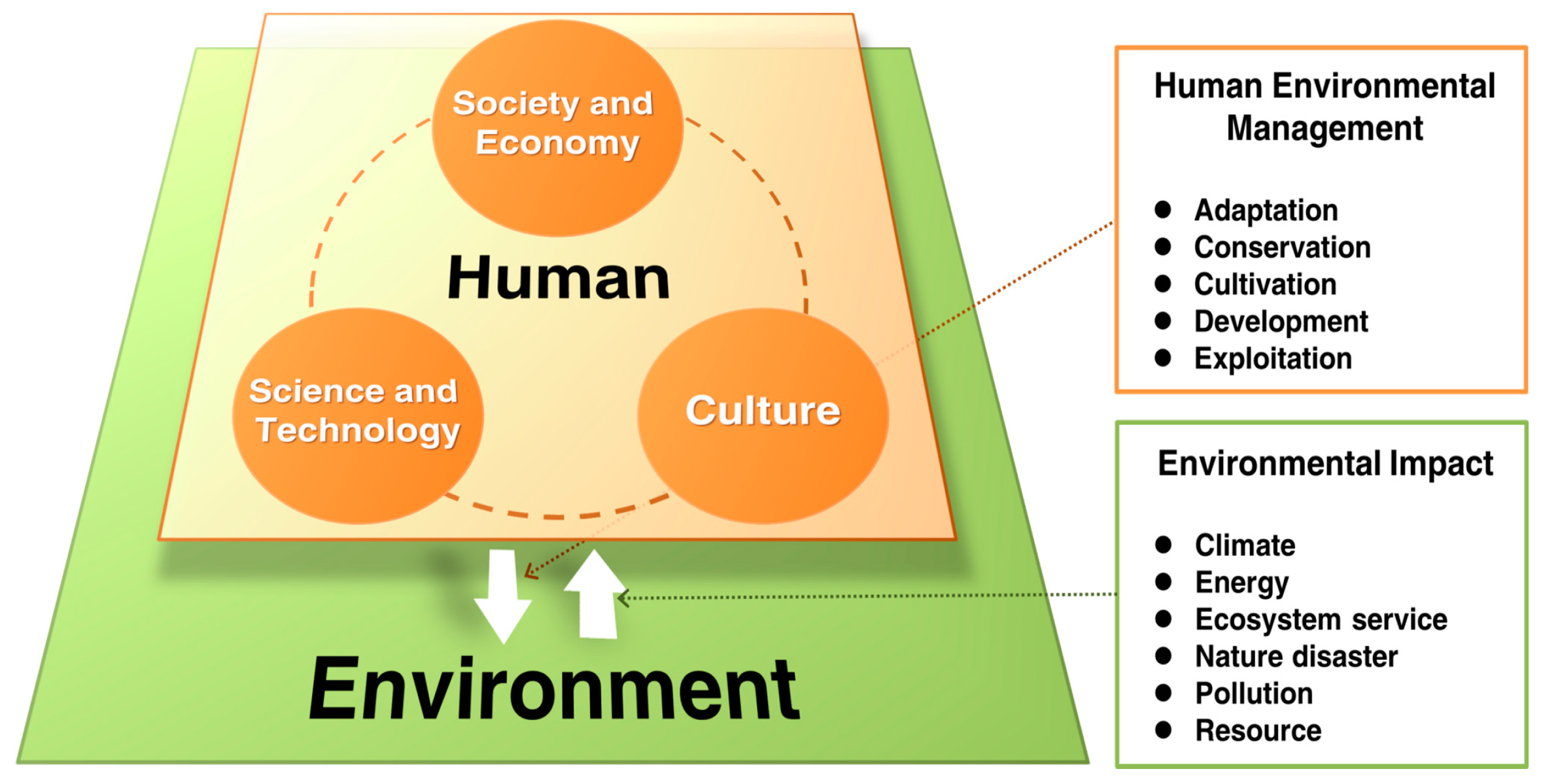
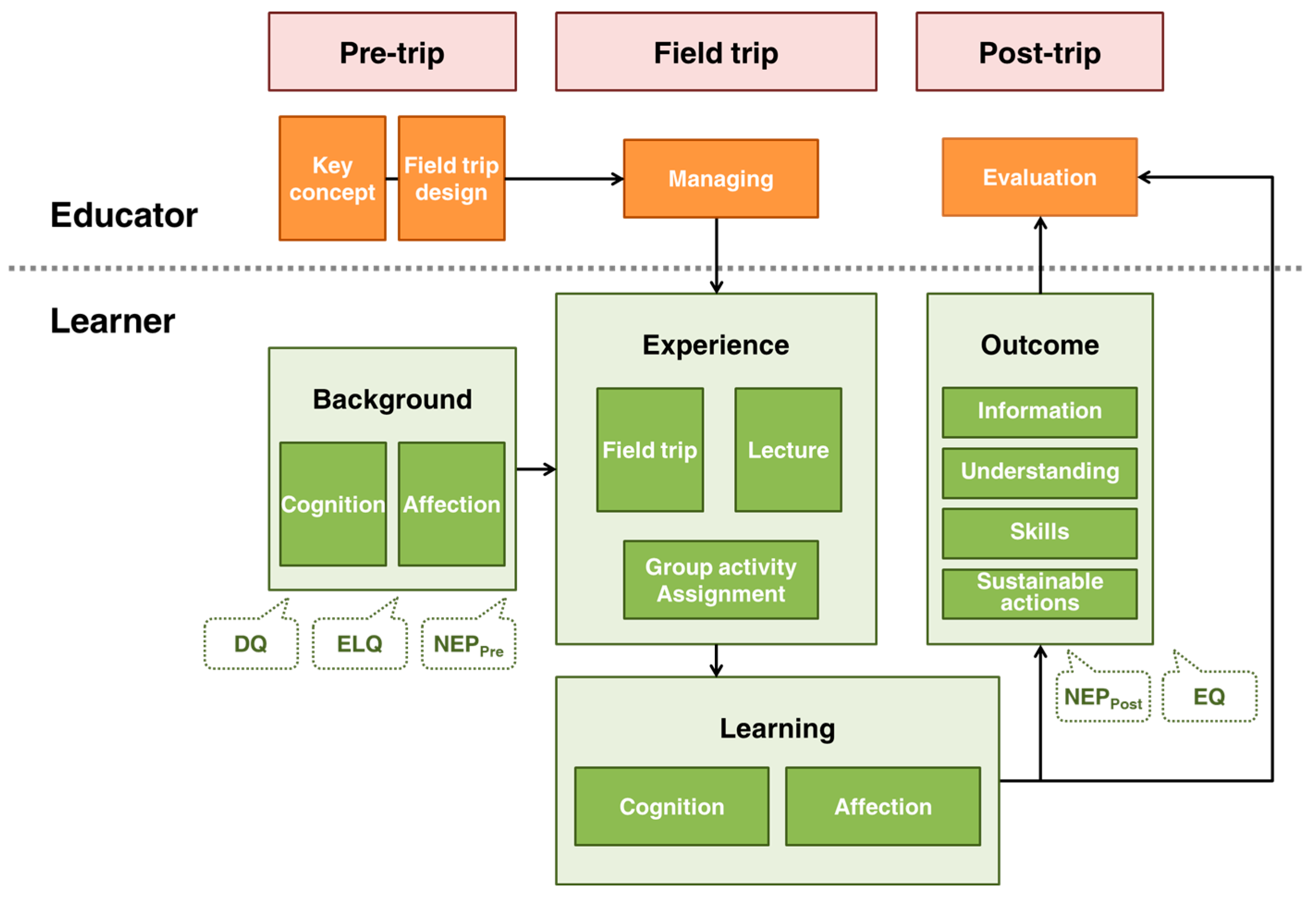
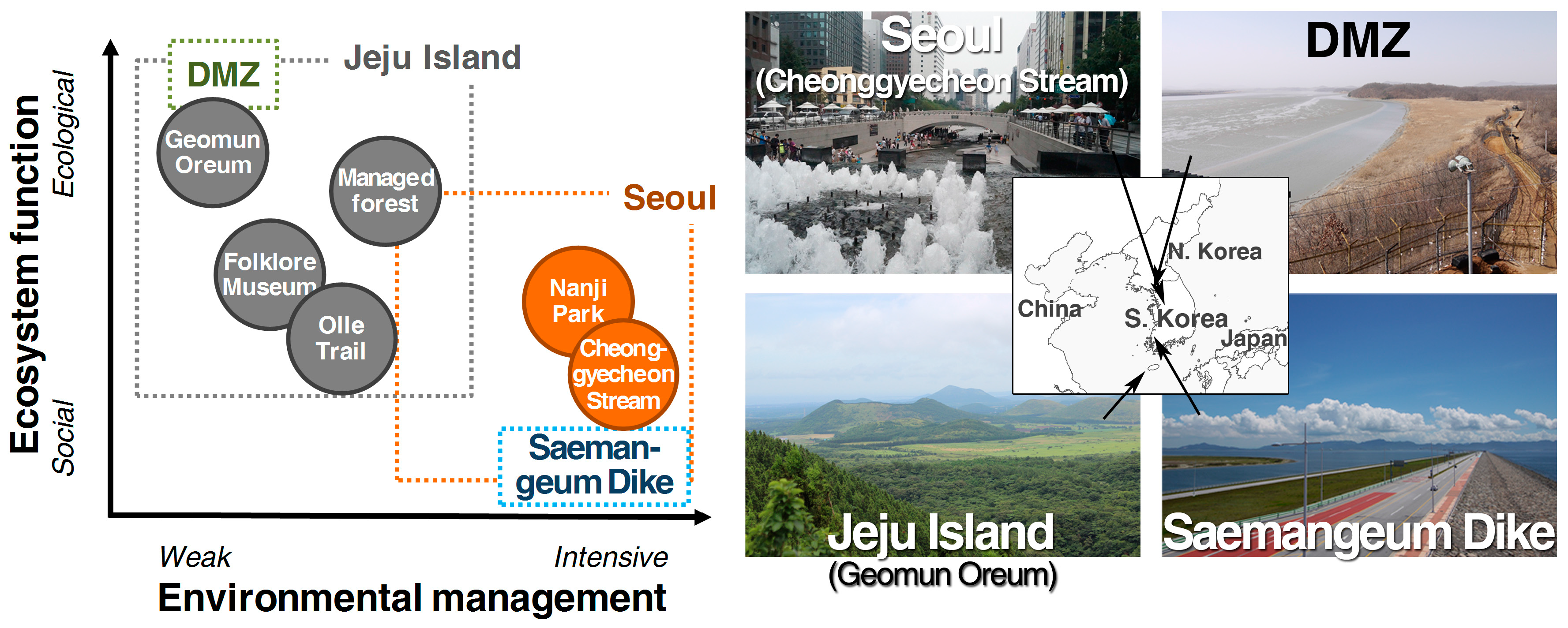
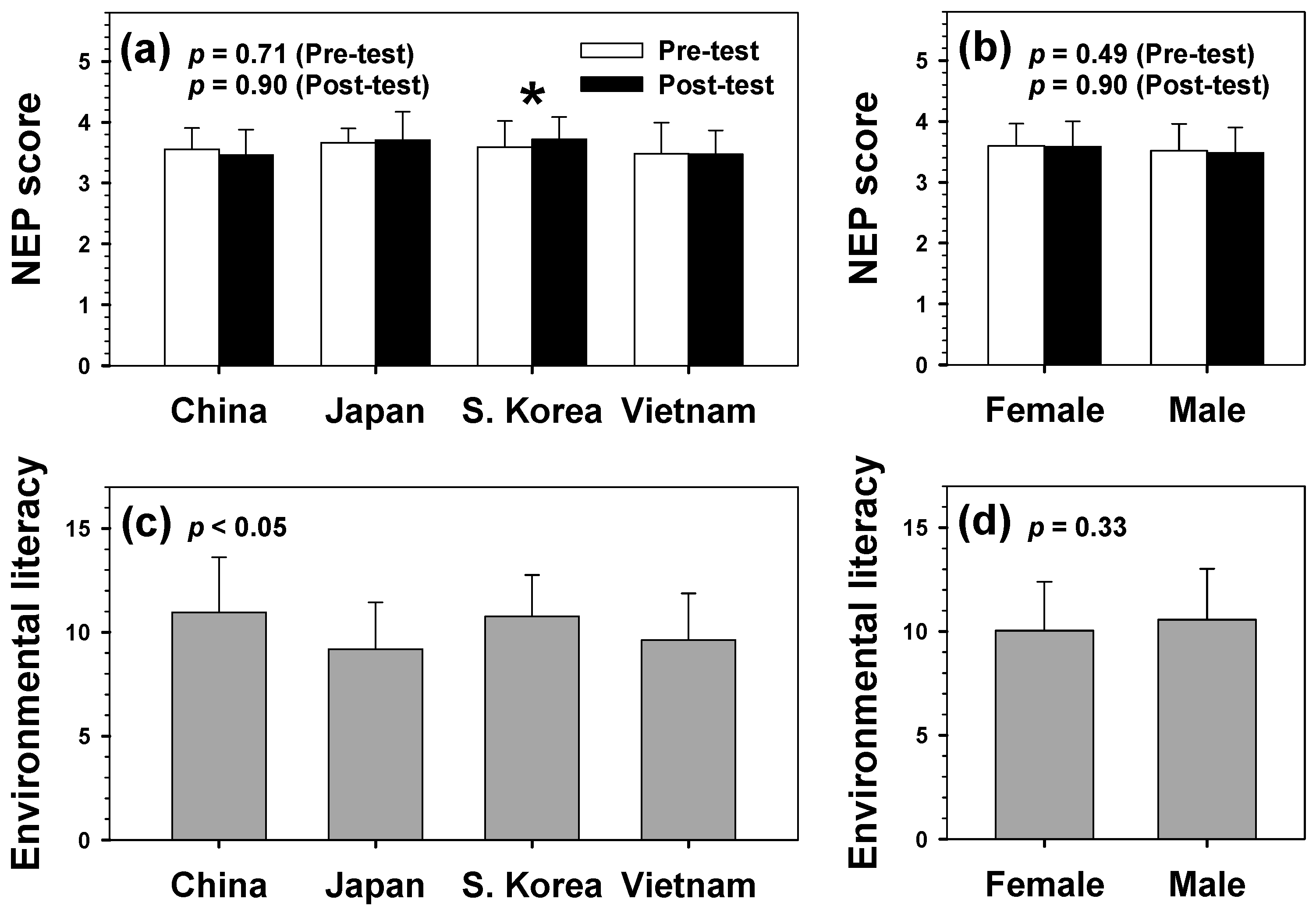
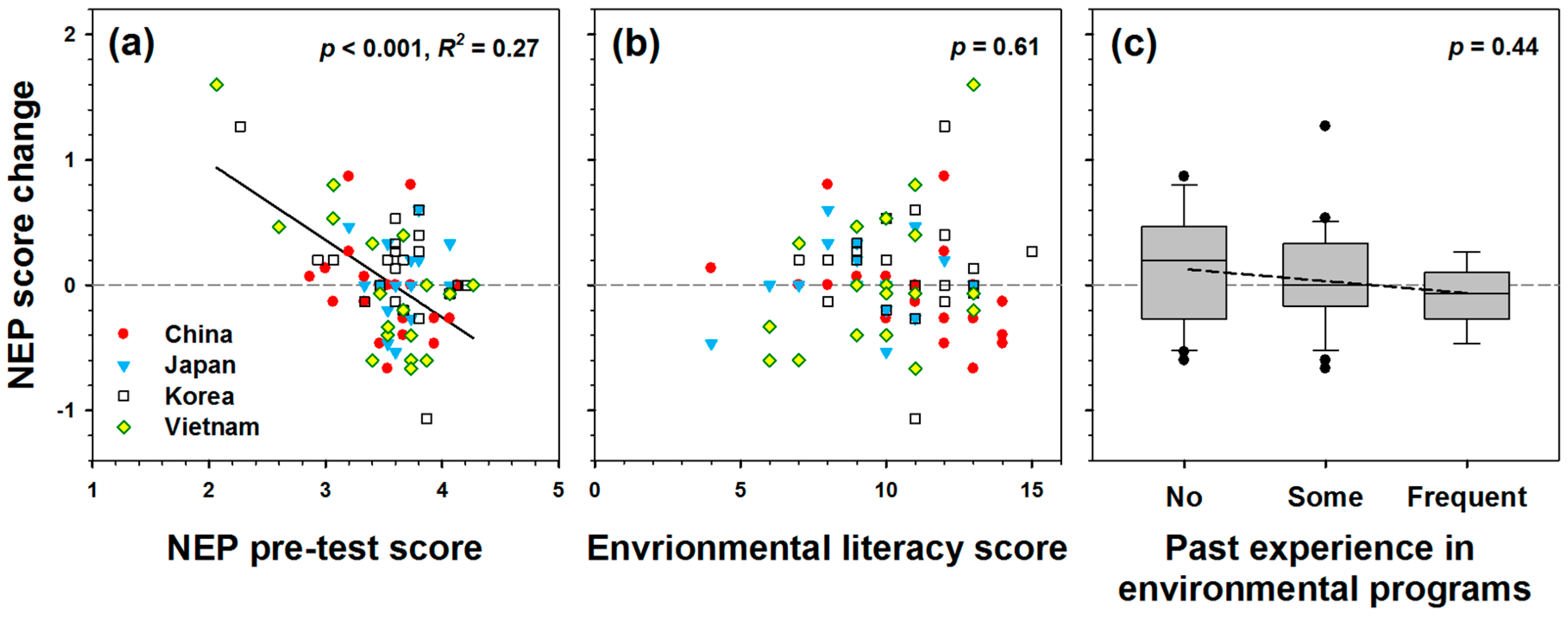
| Questionnaire Item | Total | Nationality | Gender | ||||
|---|---|---|---|---|---|---|---|
| China | Japan | South Korea | Vietnam | Female | Male | ||
| The program successfully taught the main topic about the interactions between humans and the environment (EQ-43). *,† | 4.43 (0.76) | 4.35 (0.99) | 4.55 (0.52) | 4.11 (0.76) | 4.74 (0.45) | 4.59 (0.54) | 4.13 (0.99) |
| My experience during the program will be helpful for dealing with environmental issues in my country or local community (EQ-42). | 4.32 (0.76) | 4.25 (1.02) | 4.45 (0.69) | 4.28 (0.67) | 4.37 (0.60) | 4.34 (0.61) | 4.29 (1.00) |
| My experience during the program has motivated me to be involved in environment-related activity in the future (EQ-41). | 4.44 (0.74) | 4.25 (1.02) | 4.45 (0.69) | 4.44 (0.62) | 4.63 (0.50) | 4.57 (0.55) | 4.21 (0.98) |
| The group activity with participants from other countries was effective for understanding diverse and different thoughts on the environment (EQ-39). | 4.51 (0.61) | 4.50 (0.61) | 4.55 (0.52) | 4.39 (0.78) | 4.63 (0.50) | 4.59 (0.50) | 4.38 (0.77) |
| Statement |
|---|
| Constructive learning |
| “The agreement between humans and the environment includes purposes of contract, terms and conditions, as well as regulations related to torts and other concurred provisions. The intention is to create harmony between two parties so that they co-exist, and both parties have their own rights and obligations mentioned in the contract. When one party fails to fulfill its duty without reasonable cause or violates the terms of the agreement, it must compensate for the loss of the other party during the act of the breach.” |
| “It could be said that nature provides three values that humans can benefit from: mental, social, and economic benefits. Nature provides resources and food that are needed for living. It can also be used to create business models such as tourism for economic benefit, and lastly, it has the power to provide mental relief, as I have experienced during this trip.” |
| “Here is the Kuznets curve.... We have adopted, adapted, and modified it to measure the relationships between environmental damages and the nation’s economic levels.... Once in a developing economy, nations tend to emphasize developing their well-being and put less effort into environmental protections.” |
| “I found no resource-depleted cities in South Korea. But my hometown Zaozhuang is a resource-depleted city. It was once famous for coal, but now the coal stores cannot sustain for another 20 years. So a transformation in development is urgent.” |
| “Both Ha Long Bay and Jeju Island have received the goodwill of mother of nature, but they have some differences because the environmental management is different in each country.... Our time in Jeju taught me a lot of good ideas for my country about green tourism, especially for Ha Long Bay.” “…Creating an environment where there is a win-win relationship between the environment and human activity is important to consider when thinking about how to create a sustainable society for future generations. As promoted in the Satoyama Initiative, I believe that there are possibilities for modern technology, humans, and the environment to coexist in harmony.” |
| “The biggest lesson that I learned is the method of education. People should have the chance to know both the positive and negative sides when learning about any problem.” |
| “Education should be implemented as one of the main keys to solving environmental problems because it can change all the generations and then change the whole world.” |
| “In order to improve the quality of an environmental management system, it is truly essential for a country to educate more and more generations of future leaders with a multidisciplinary approach.” |
| “Field experiences are a more effective way to learn about the environment than lectures.” |
| “Not only did I learn much knowledge, but I also participated in group work and formed good relationships with many outstanding students, and we became good friends.” |
| “I realized that the communication between different countries and different cultures is very useful and important.” |
| “It would be better to introduce to the students more details about environment-friendly technology.” |
| “The program was very well organized. But the tight schedule was a little bit tiring.” |
| Questionnaire Item | Jeju | Saemangeum | DMZ | Seoul |
|---|---|---|---|---|
| I learned a lesson about the interactions between humans and the environment from the site. * | 4.54 (0.58) | 4.24 (0.81) | 3.68 (1.00) | 4.12 (0.87) |
| The site could be an excellent place for environmental education. * | 4.31 (0.74) | 3.81 (1.12) | 3.63 (1.02) | 4.24 (0.74) |
© 2016 by the authors; licensee MDPI, Basel, Switzerland. This article is an open access article distributed under the terms and conditions of the Creative Commons Attribution (CC-BY) license (http://creativecommons.org/licenses/by/4.0/).
Share and Cite
Yoon, T.K.; Kim, S.; Takano, T.; Yun, S.-J.; Son, Y. Contributing to Sustainability Education of East Asian University Students through a Field Trip Experience: A Social-Ecological Perspective. Sustainability 2016, 8, 1067. https://doi.org/10.3390/su8101067
Yoon TK, Kim S, Takano T, Yun S-J, Son Y. Contributing to Sustainability Education of East Asian University Students through a Field Trip Experience: A Social-Ecological Perspective. Sustainability. 2016; 8(10):1067. https://doi.org/10.3390/su8101067
Chicago/Turabian StyleYoon, Tae Kyung, Seongjun Kim, Takako Takano, Sun-Jin Yun, and Yowhan Son. 2016. "Contributing to Sustainability Education of East Asian University Students through a Field Trip Experience: A Social-Ecological Perspective" Sustainability 8, no. 10: 1067. https://doi.org/10.3390/su8101067






